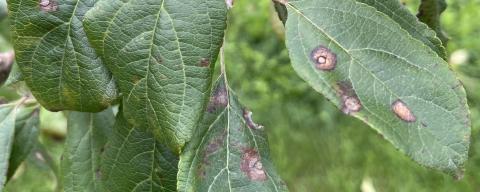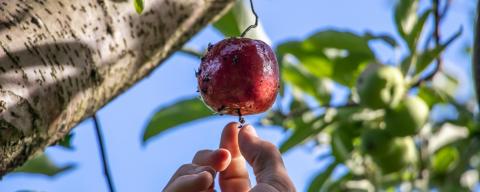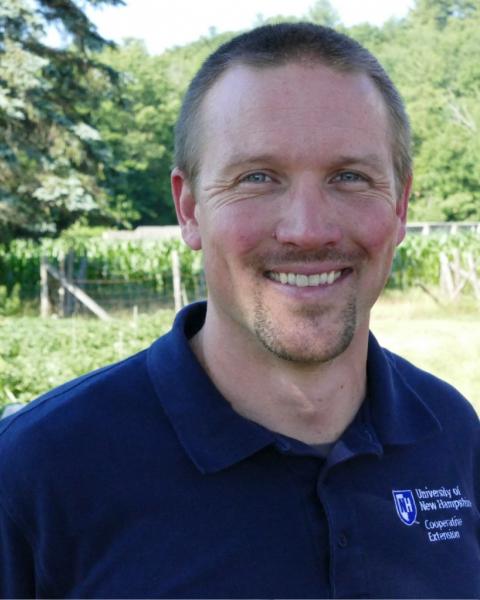By Bo Liu, Director of the UNH Plant Diagnostic Lab and State Extension Specialist, Plant Pathology, Jeremy Delisle, UNH Extension Field Specialist, Fruit & Vegetable Production, and William Hastings, UNH Extension Field Specialist, Fruit & Vegetable Production
Published February 2025
Frogeye leaf spot and black rot caused by the fungus Botryosphaeria obtuse (Schwein) is an economically important disease of apple in the Northern and Central parts of North America. In recent years, it has become a concern in apple production in New Hampshire. Frogeye leaf spot affects leaves and is the same pathogen that causes black rot on fruit and black rot canker on branches. The disease reduces fruit yield, quality, and marketability, weakens tree vigor, and causes severe damage to apples in commercial orchards and backyard trees.
Symptoms
Frogeye leaf spot: leaf lesions start at petal-fall as small, circular, and brown spots surrounded by dark-brown concentric rings, which resemble a frog's eye (Fig. 1). Black pycnidia (fungal fruiting body), like those that appear on rotted fruit, develop on the upper surface in the center of the older leaf spots, which help to distinguish frogeye leaf spots from similar spots caused by spray injury. Severely infected leaves eventually turn yellow and drop.
Black rot on fruit: Symptoms appear often at the calyx or stem ends (Fig. 2). As the lesions enlarge, they turn black, or chestnut colored with concentric rings (Fig. 3), and in advanced stages, fruit may mummify. Pycnidia (asexual fruiting of the fungus) containing spores of the black rot fungus appear on the surface of rotted tissue.
Black rot canker on limbs and trunks: Symptoms on diseased limbs and trunks resemble fire blight, branch cankers initially appear as slightly sunken reddish-brown areas in the bark (Fig. 4), as symptom progress, the wood will shrink and become black with cracked edges. Severely affected limbs may be fully girdled by cankers and die back (Fig. 5).
Causal agent
Frogeye leaf spot and black rot are caused by the ascomycete fungus Botryosphaeria obtuse (synonyms: Diplodia seriata) (Fig. 6).
Life cycle
The fungus survives and overwinters in diseased plant cankers, leaves and mummified fruits. Damaged branches or those with winter injury or fire blight are more susceptible to black rot. The fungus has two types of inoculums - ascospore (sexual spores) and conidia (asexual spores) from pycnidia, which are released from pycnidia. In the spring, the spores are released early in the season around bud swell. Conidia continue to be released from pycnidia throughout the growing season. Ascospores are primarily wind-blown. Both ascospores and conidia require a wet period and are spread by rain splashing, wind and insects. The fungus penetrates through stomata (gas exchange sites) or wounds in the fruits, leaves or branches through mechanical or environmental damage. The optimum temperature for leaf infection is 26 ℃ (79 F) after four to five hours of leaf wetting, and fruit infection occurs at 20℃ (68 F) to 24 ℃ (75 F) with nine hours of wetting. Favorable conditions for fungal infection include prolonged wet periods, high humidity, and moderate to warm temperatures. Trees stressed due to winter injury, drought, poor nutrition, or wounds are more susceptible to this disease.
Management
Sanitation and cultural practices: Clean up leaf litter, remove mummified fruit, dead trees, dead or dying infected limbs, prune out cankered limbs in late fall to early spring, since they can serve as an inoculum source for disease infection next season.
Maintain tree health: Any practice that keeps trees healthy will prevent black rot canker development. Cankers generally develop only on stressed or weakened trees. Prune trees annually and maintain a balanced fertility program. Take measures to minimize stress factors including winter injuries, water stress, mechanical injury, disease, or insect damage.
Chemical control: Apply fungicides during early season growth, and regular sprays may be required during wet growing seasons. For currently labeled fungicides, please refer to the New England Tree Fruit Management Guide.
Resistant Varieties: All apple cultivars are susceptible to this disease. McIntosh, Cortland, Empire and Northern Spy varieties are more susceptible to this disease. Consider planting less susceptible varieties.
References
Bulatovic-Danilovich, M. Black rot disease in apples - Botryosphaeria obtusa (Schwein). ANR-IPM-18-002 (https://extension.wvu.edu/files/d/7630f5af-2f89-489d-a411-fc5410982ced/…)
Gauthier, N.W., and Rideout, P.A. Frogeye leaf spot and black rot of apple. PPFS-FR-T-03 (https://plantpathology.ca.uky.edu/files/ppfs-fr-t-03.pdf)
Khan, A. Black rot and frogeye leaf spot. (https://blogs.cornell.edu/applevarietydatabase/fact-sheet-frogeye-leaf-…)
Biggs, A.R. and Miller, S.S. 2004. Relative susceptibility of selected apple cultivars to fruit rot caused by Botryosphaeria obtuse. HortScience 39:303-306.
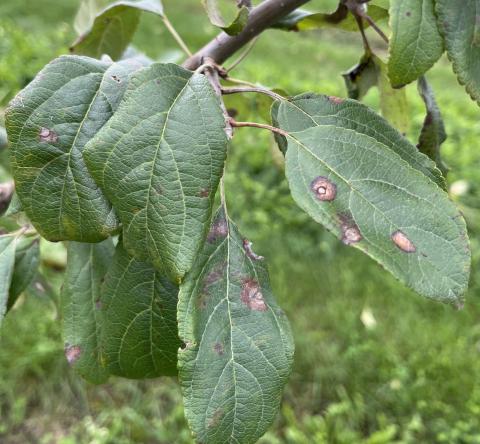
Figure 1. Leaf symptoms with frog-eye concentric lesions with a tan center and dark margins.
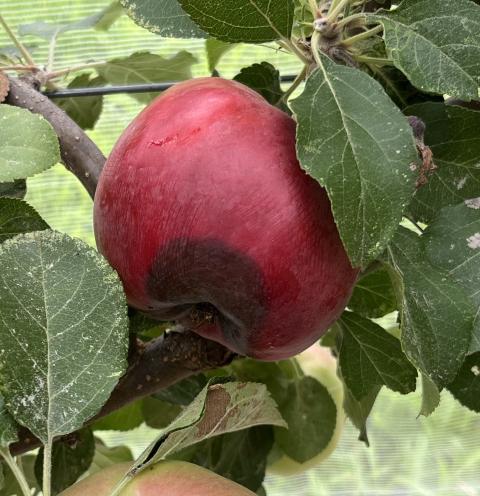
Figure 2. Black rot on fruit that often begins at the blossom end.
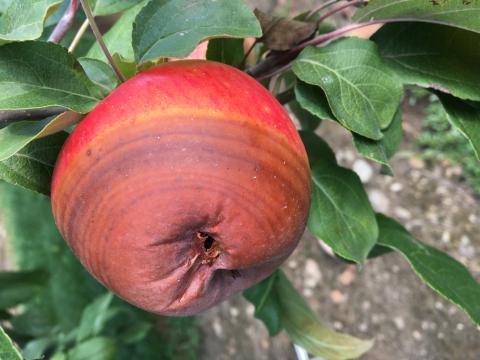
Figure 3. Black rot on fruit with concentric rings.
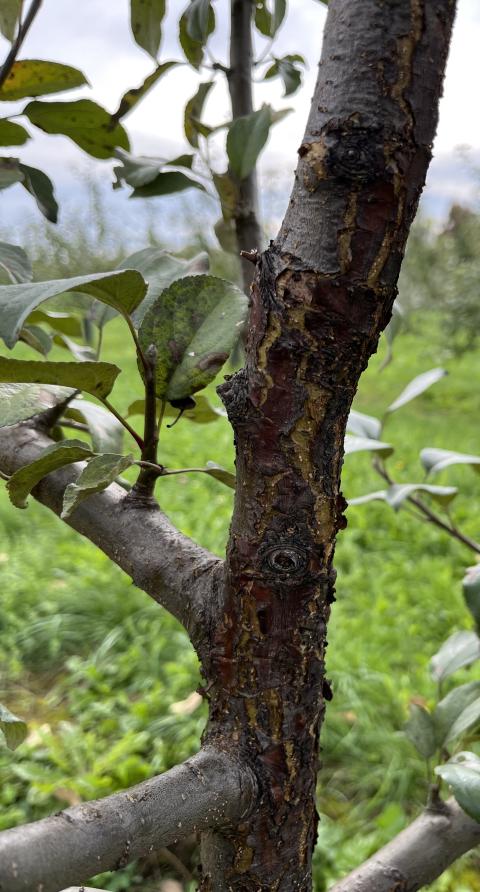
Figure 4. Black rot canker on tree trunk.
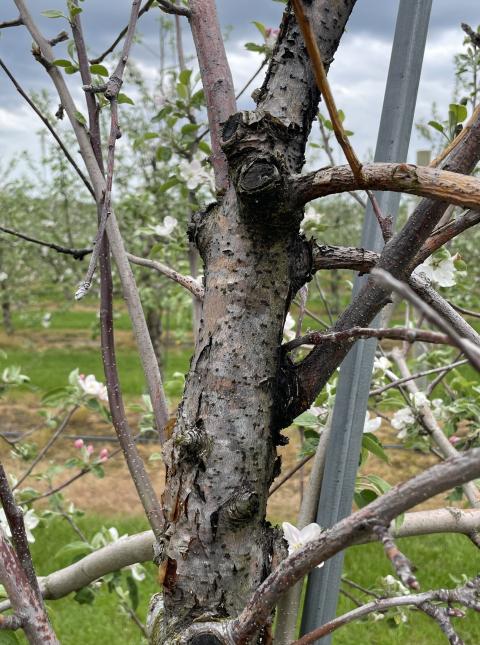
Figure 5. Black rot canker showing dry, blistery, and peeling lesions.

Figure 6. Asexual conidia of Botryosphaeria obtuse.
Extension Services & Tools That Help NH Farmers Grow
Newsletters: Choose from our many newsletters for production agriculture
Receive Pest Text Alerts - Text UNHIPM to (866) 645-7010
